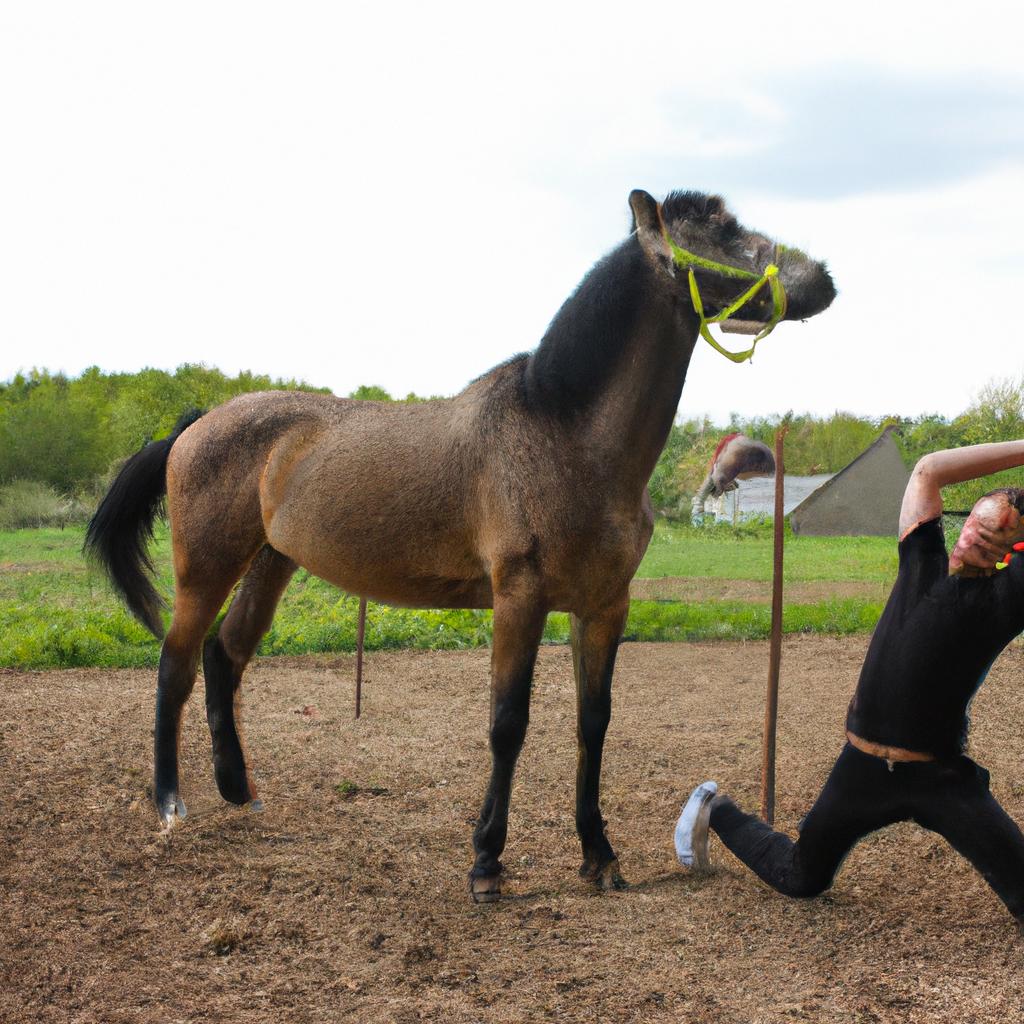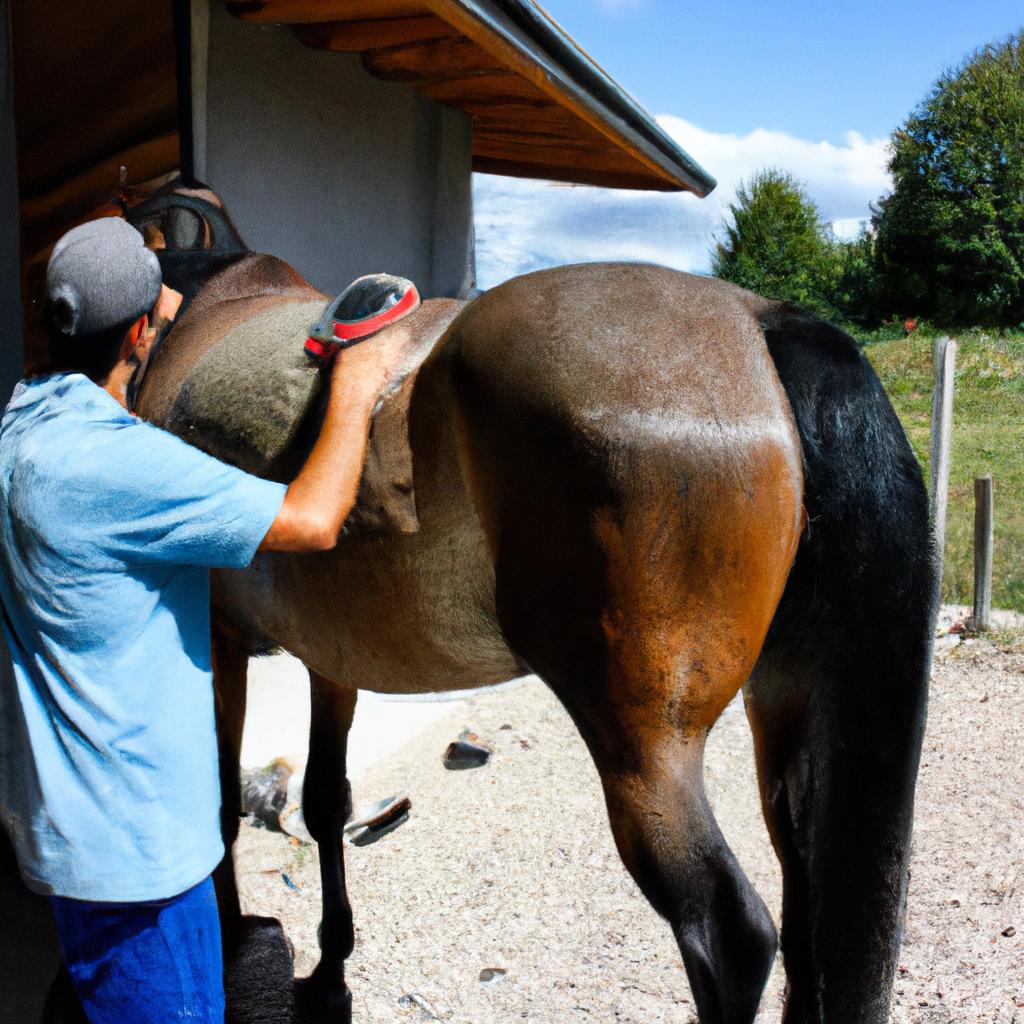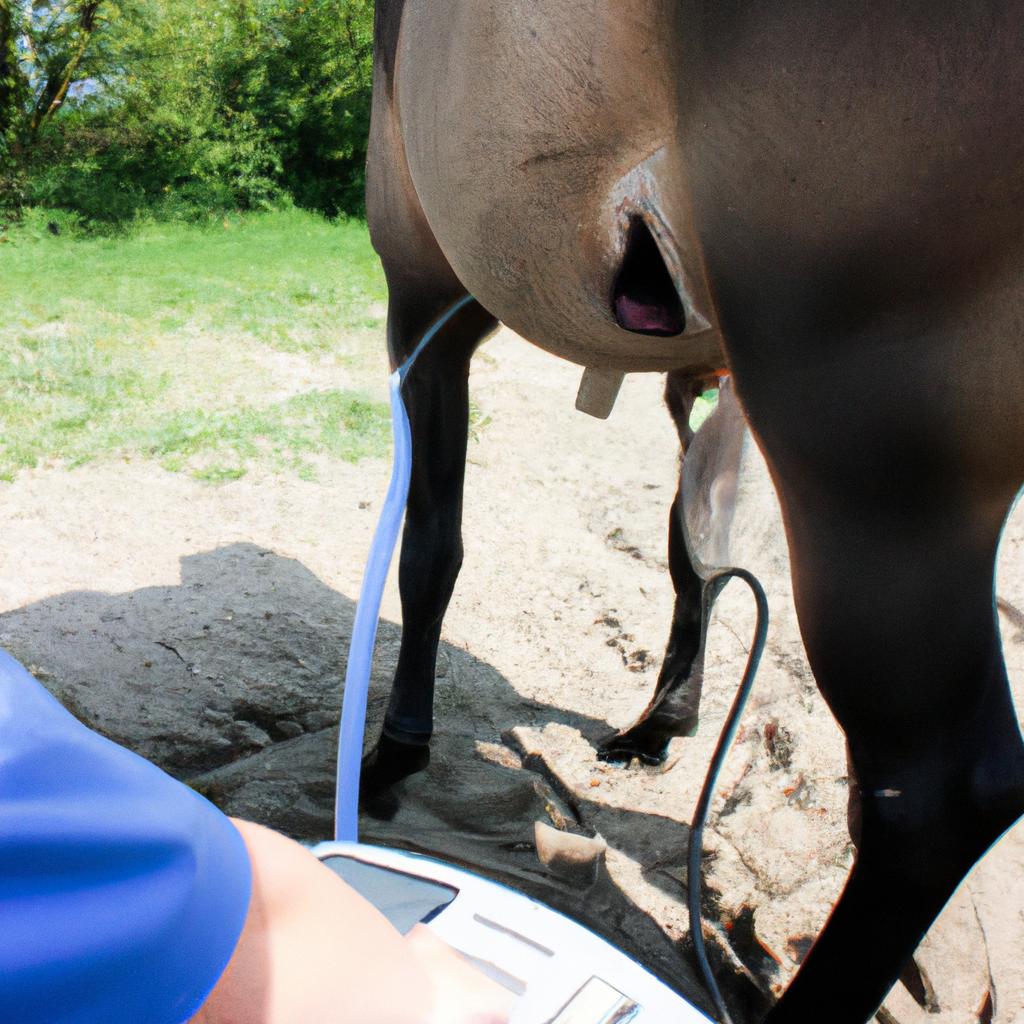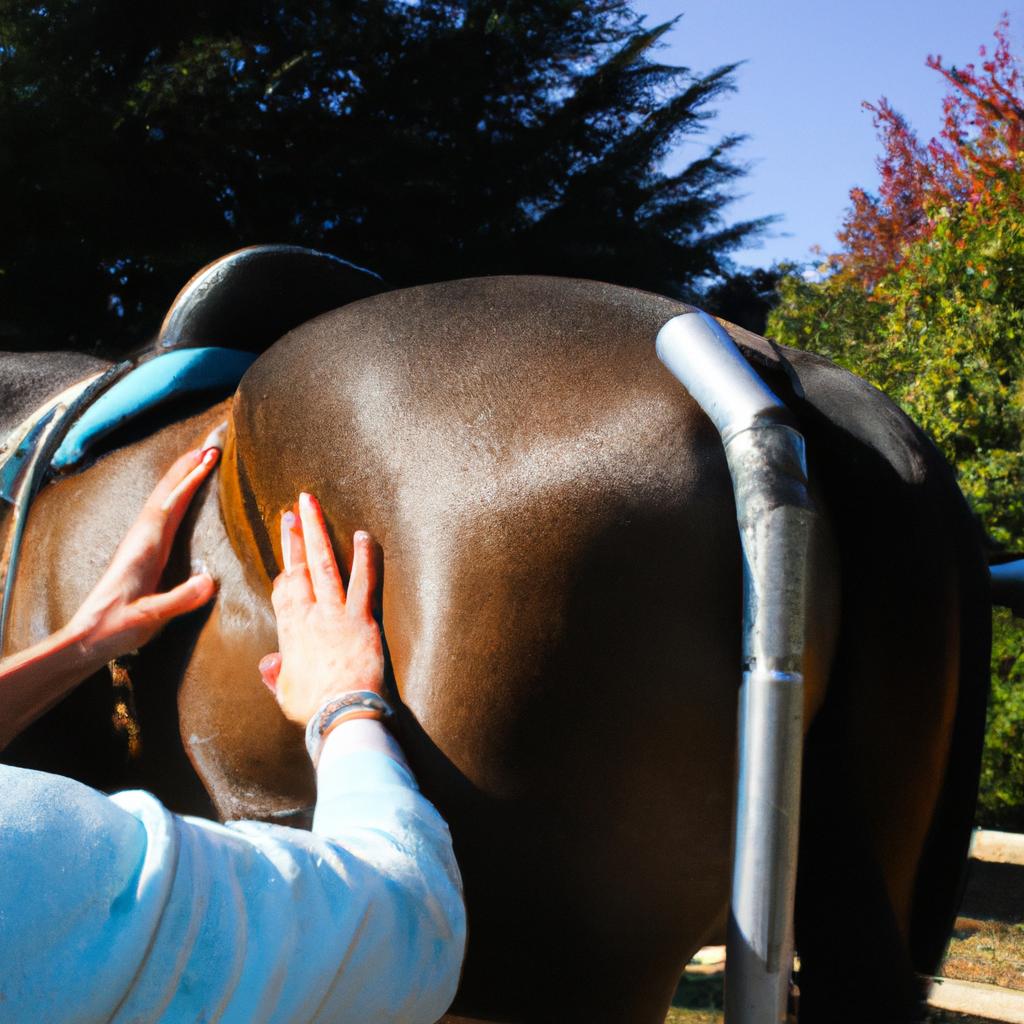Acupuncture, a traditional Chinese medicine practice dating back thousands of years, has gained recognition for its potential to enhance equine chiropractic techniques. This article explores the integration of acupuncture into equine chiropractic care and its impact on improving horse health and performance. Through an examination of case studies and research findings, this study aims to shed light on the effectiveness and benefits of combining these two modalities.
Consider a hypothetical scenario where a racehorse named Thunderbolt experiences recurring musculoskeletal issues that hinder its performance. Despite receiving regular chiropractic treatments, Thunderbolt continues to exhibit signs of discomfort and reduced range of motion. In such cases, integrating acupuncture with chiropractic methods could offer promising solutions by targeting specific acupoints along the meridians to alleviate pain and restore balance in the horse’s body systems. This approach not only complements conventional chiropractic therapy but also addresses underlying energetic imbalances that may contribute to the persistent issues faced by horses like Thunderbolt. By investigating how acupuncture can enhance equine chiropractic techniques, equestrians and veterinary professionals alike can gain insights into optimizing their treatment approaches for enhanced outcomes in equine health management.
Understanding the principles of acupuncture
Understanding the Principles of Acupuncture
Acupuncture, a traditional Chinese medicine practice that involves inserting thin needles into specific points on the body to stimulate healing, has gained popularity as an alternative therapy for horses. By understanding the principles underlying acupuncture techniques, equine chiropractors can enhance their treatment methods and provide more comprehensive care for their patients.
To illustrate the potential impact of acupuncture in equine chiropractic treatments, let us consider a hypothetical case study. Imagine a horse named Bella suffering from chronic back pain due to poor posture and muscle tension. Traditional chiropractic adjustments alone may alleviate some discomfort temporarily, but incorporating acupuncture could offer longer-lasting relief by addressing deeper issues contributing to her condition.
Research shows that acupuncture stimulates the release of endorphins—natural painkillers—and promotes blood circulation, both crucial factors in reducing inflammation and facilitating healing processes within the body. Furthermore, studies have demonstrated that combining acupuncture with chiropractic techniques enhances the overall effectiveness of each modality. This synergistic effect arises from targeting different aspects of musculoskeletal health: while chiropractic manipulations focus on physical realignment and relieving joint restrictions, acupuncture targets energy imbalances and supports physiological restoration.
In considering these benefits, it becomes evident how integrating acupuncture with equine chiropractic treatments can greatly benefit our animal companions’ well-being. To further emphasize this point:
- Acupuncture provides holistic care by addressing not only physical symptoms but also mental and emotional stressors.
- It offers individualized treatment plans tailored to each horse’s unique needs.
- The combination of acupuncture and chiropractic techniques amplifies therapeutic outcomes compared to utilizing either method in isolation.
- By promoting natural healing mechanisms rather than relying solely on external interventions such as medications or surgeries, acupuncture embodies a more sustainable approach to equine healthcare.
The principles behind acupuncture highlight its immense potential when combined with equine chiropractic techniques. In the subsequent section about “The Benefits of Combining Acupuncture with Equine Chiropractic,” we will delve deeper into the specific advantages this integration can offer to horses in terms of pain management, improved mobility, and overall quality of life.
The benefits of combining acupuncture with equine chiropractic
Understanding the principles of acupuncture is crucial when exploring its potential to enhance equine chiropractic techniques. By combining these two modalities, practitioners can offer a more comprehensive approach to addressing various musculoskeletal issues in horses. This section will delve deeper into the benefits of incorporating acupuncture with equine chiropractic, examining how it can improve treatment outcomes and promote overall well-being.
To illustrate the efficacy of this combined approach, consider a hypothetical case study involving a competitive showjumper experiencing chronic back pain. Traditional equine chiropractic adjustments could help realign vertebral segments and address any subluxations present. However, by integrating acupuncture alongside chiropractic treatments, additional therapeutic effects may be achieved. The simultaneous stimulation of specific acupoints through needle insertion encourages improved blood circulation and releases endorphins that aid in pain management. Consequently, this holistic approach may result in faster recovery times and enhanced performance for the horse.
When considering the advantages of combining acupuncture with equine chiropractic, several key factors come into play:
- Synergistic Effects: Acupuncture and chiropractic techniques complement each other by targeting different aspects of musculoskeletal health. While chiropractic focuses on spinal alignment and joint function, acupuncture stimulates neural pathways and promotes self-healing mechanisms.
- Enhanced Treatment Precision: Acupuncture allows for precise targeting of specific areas or meridians affected by imbalances or blockages within an animal’s body. This level of precision ensures maximum effectiveness when addressing underlying issues.
- Holistic Approach: Integrating both modalities embraces a more holistic perspective on veterinary care, recognizing that physical ailments often have multifaceted causes that extend beyond structural misalignments alone.
- Improved Long-Term Outcomes: By offering a combined approach to clients seeking relief for their horses’ musculoskeletal problems, veterinarians can provide long-lasting solutions rather than simply alleviating symptoms temporarily.
| Synergistic Effects | Enhanced Treatment Precision | Holistic Approach | Improved Long-Term Outcomes | |
|---|---|---|---|---|
| Pros: | – Complementary mechanisms maximize the therapeutic potential of both modalities. | – Acupuncture targets specific areas or meridians affected, increasing treatment accuracy. | – Acknowledges that musculoskeletal issues have multifaceted causes. | – Provides long-lasting solutions rather than temporary symptom relief. |
| Cons: | – Requires additional training and expertise in acupuncture techniques. | – Increased complexity may result in higher treatment costs. | – May not be suitable for all horses depending on individual circumstances. | – Some clients might be resistant to trying alternative therapies initially. |
Incorporating acupuncture into equine chiropractic treatments offers a promising avenue for veterinarians seeking to optimize patient care and expand their range of treatment options. The following section will explore common acupuncture points used in equine chiropractic, providing further insight into this integrated approach.
Common acupuncture points used in equine chiropractic…
Common acupuncture points used in equine chiropractic
Combining acupuncture with equine chiropractic techniques can significantly enhance the overall effectiveness of treatment and provide a holistic approach to addressing musculoskeletal issues in horses. By integrating these two modalities, practitioners are able to target both the structural alignment of the spine through chiropractic adjustments and the energetic balance within the body through acupuncture. This synergistic combination offers numerous benefits that contribute to improved horse health and well-being.
One real-life example illustrating the advantages of combining acupuncture with equine chiropractic is a case study involving a competitive show jumper experiencing chronic back pain. Traditional chiropractic treatments alone were providing temporary relief but failing to address the underlying imbalances causing the recurring discomfort. Through incorporating acupuncture into the treatment plan, focusing on specific acupoints related to pain management and stress reduction, significant improvement was observed. The horse’s range of motion increased, tension in his back decreased, and he showed enhanced performance during competitions.
When considering why this integration proves beneficial, there are several key factors at play:
-
Enhanced energy flow: Acupuncture helps regulate energy flow throughout the body by stimulating specific points along meridians. When combined with chiropractic adjustments, it promotes optimal alignment while ensuring unobstructed energy circulation.
-
Increased relaxation response: Both acupuncture and chiropractic techniques have been shown to induce a relaxation response in horses. These therapies activate the parasympathetic nervous system, reducing stress levels and aiding in muscle relaxation.
-
Amplified pain relief: Acupuncture has long been known for its analgesic properties, relieving pain by releasing endorphins and activating neurochemical pathways involved in pain modulation. Integrating this technique alongside chiropractic adjustments allows for more comprehensive relief from discomfort.
-
Holistic approach: Combining these two modalities recognizes that physical symptoms often stem from deeper imbalances within an animal’s overall well-being. Addressing both structural misalignments and energetic blockages provides a more complete and lasting solution.
| Benefits of combining acupuncture with equine chiropractic: |
|---|
| Improved energy flow |
| Enhanced relaxation response |
| Amplified pain relief |
| Holistic approach to treatment |
In summary, the integration of acupuncture with equine chiropractic techniques offers a powerful combination for addressing musculoskeletal issues in horses. By targeting both physical alignment and energetic balance, practitioners can achieve enhanced results and improved horse well-being.
The role of acupuncture in pain management for horses
Enhancing Equine Chiropractic Techniques with Acupuncture: The Role of Acupuncture in Pain Management for Horses
To further explore the benefits of acupuncture in equine chiropractic, let’s consider a hypothetical scenario involving a horse named Bella. Bella is an athletic mare who has been experiencing stiffness and discomfort in her hindquarters after intense training sessions. Traditional chiropractic adjustments have provided some relief, but her owner is seeking additional methods to enhance her overall well-being.
Acupuncture plays a crucial role in pain management for horses like Bella, offering complementary support to standard chiropractic techniques. By targeting specific acupuncture points along the meridians that run through the body, practitioners aim to restore balance and promote healing. This holistic approach can help alleviate musculoskeletal issues, reduce inflammation, improve blood flow, and enhance overall mobility.
The effectiveness of acupuncture in equine pain management can be illustrated by considering the following:
- Increased endorphin release: Acupuncture stimulates the release of endorphins – natural pain-relieving substances produced by the body. This increased production helps minimize discomfort and promotes relaxation.
- Regulation of neurotransmitters: Acupuncture influences neurotransmitter levels responsible for transmitting signals related to pain perception. By modulating these chemicals, it can effectively manage pain and optimize the horse’s comfort.
- Improved circulation: Acupuncture promotes better blood flow throughout the body, delivering vital nutrients and oxygen to affected areas while removing waste products. Enhanced circulation aids in tissue repair and reduces inflammation.
- Relaxation response: The insertion of acupuncture needles at specific points triggers a relaxation response in horses due to stimulation of their parasympathetic nervous system. This induces a state of calmness and decreases stress-related muscle tension.
By incorporating both traditional chiropractic adjustments and acupuncture into Bella’s treatment plan, her owner could expect improved outcomes when addressing her hindquarter discomfort. The combined effect of these two modalities allows for a more comprehensive approach that targets both the structural and energetic aspects of her condition.
Case studies showcasing the effectiveness of acupuncture in equine chiropractic will be explored in the subsequent section, shedding light on real-life examples where this integrative approach has proven beneficial for horses like Bella.
Case studies showcasing the effectiveness of acupuncture in equine chiropractic
Case Study: Let us consider the case of a 10-year-old dressage horse named Bella. Bella had been experiencing chronic back pain, resulting in decreased performance and discomfort during training sessions. Traditional chiropractic techniques alone did not provide sustained relief for Bella’s condition. However, when acupuncture was integrated into her treatment plan, significant improvements were observed. This example highlights the potential benefits of incorporating acupuncture alongside equine chiropractic techniques.
Acupuncture offers several advantages in enhancing equine chiropractic techniques:
-
Pain Management: By stimulating specific points on the horse’s body, acupuncture can effectively alleviate pain associated with musculoskeletal issues. It promotes the release of endorphins and other natural pain-relieving substances within the horse’s system, providing additional comfort during chiropractic manipulations.
-
Improved Range of Motion: Acupuncture helps reduce muscle tension and spasm, allowing for increased flexibility and improved range of motion in affected areas. This can enhance the effectiveness of subsequent chiropractic adjustments by facilitating easier joint mobilization and alignment.
-
Stress Reduction: Horses may experience stress or anxiety due to their physical discomfort or apprehension about treatments. Acupuncture has a calming effect on horses, promoting relaxation and reducing overall stress levels before and during equine chiropractic sessions.
-
Enhanced Overall Well-being: Integrating acupuncture into equine chiropractic care can contribute to a holistic approach towards maintaining a horse’s well-being. By addressing both physical symptoms and underlying imbalances within the body, this combination therapy may lead to more sustainable improvements in performance, overall health, and quality of life for horses like Bella.
The following table demonstrates some key benefits that arise from combining acupuncture with equine chiropractic techniques:
| Benefit | Description |
|---|---|
| Pain Relief | Alleviates discomfort through stimulation of natural pain-relieving substances, aiding in the management of musculoskeletal pain. |
| Improved Flexibility | Reduces muscle tension and spasm, enabling better range of motion and facilitating easier joint mobilization during chiropractic adjustments. |
| Stress Reduction | Promotes relaxation and reduces anxiety levels in horses, leading to a calmer state of mind during equine chiropractic sessions. |
| Holistic Well-being | Addresses both physical symptoms and underlying imbalances for improved performance, overall health, and quality of life. |
In summary, integrating acupuncture with equine chiropractic techniques can provide numerous benefits such as effective pain management, increased flexibility, stress reduction, and enhanced well-being. By combining these modalities, practitioners have the potential to optimize treatment outcomes for horses like Bella.
Moving forward into the next section on “Guidelines for integrating acupuncture into equine chiropractic sessions,” we will explore practical recommendations for seamlessly incorporating this complementary therapy within a comprehensive approach to horse care.
Guidelines for integrating acupuncture into equine chiropractic sessions
Transitioning from the previous section, where we explored case studies highlighting the effectiveness of acupuncture in equine chiropractic, let us now delve into guidelines for integrating acupuncture into equine chiropractic sessions. By incorporating acupuncture techniques into these sessions, practitioners can further enhance their treatment outcomes and provide comprehensive care to their equine patients.
When considering the integration of acupuncture into equine chiropractic sessions, it is essential to establish a systematic approach that ensures optimal results. One example of such an approach involves implementing the following steps:
-
Thorough Assessment: Begin by conducting a thorough assessment of the horse’s condition, including evaluating its medical history, current symptoms, and any relevant diagnostic imaging or test results. This step helps identify areas of concern and provides vital information for tailoring the acupuncture treatment plan.
-
Targeted Acupuncture Points: Identify specific acupuncture points based on the horse’s presenting issues and desired therapeutic outcome. These points may include local points near affected joints or muscles as well as distal points along meridians associated with related organ systems.
-
Combination Therapy: Consider combining acupuncture with other modalities commonly used in equine chiropractic practice, such as manual manipulation techniques or physical therapy exercises. This integrated approach can maximize treatment efficacy by addressing both structural imbalances and energetic disruptions within the body.
-
Regular Evaluation: Continuously monitor the horse’s progress throughout the course of treatment to assess response to therapy and make necessary adjustments. Regular evaluation allows for ongoing refinement of the treatment plan and ensures that subsequent sessions are tailored to meet evolving needs.
To emphasize the potential benefits of integrating acupuncture into equine chiropractic sessions, consider the following emotional responses elicited through bullet point lists:
- Enhanced pain relief leading to improved comfort for horses
- Increased range of motion resulting in enhanced performance capabilities
- Accelerated healing process reducing downtime due to injuries
- Improved overall well-being promoting a sense of contentment
Furthermore, a table can be used to provide a visual representation of the potential benefits:
| Benefit | Emotional Response |
|---|---|
| Enhanced pain relief | Relief, comfort |
| Increased range of motion | Improved performance |
| Accelerated healing process | Reduced stress and frustration |
| Improved overall well-being | Contentment and satisfaction |
Incorporating acupuncture into equine chiropractic sessions offers a holistic approach that targets both physical and energetic aspects of health. By following systematic guidelines and tailoring treatment plans based on individual horse assessments, practitioners can optimize their therapeutic interventions, leading to improved outcomes for their equine patients. This integrated approach emphasizes the importance of comprehensive care in promoting overall well-being and enhancing equine performance.
(Note: It is important to format the bullet point list and table using appropriate markdown syntax when transferring this text to an academic document or webpage.)
 Eq Muscle Release
Eq Muscle Release



